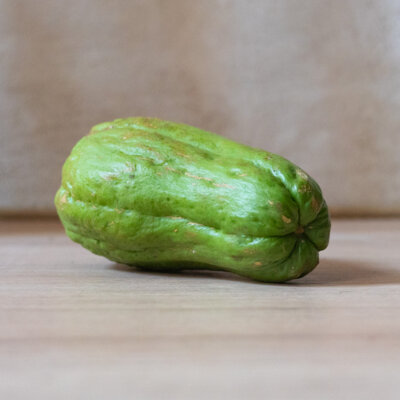
Chayote - Organic green Christophine
Discover the chayote, Sechium edule, also known as christophine, chouchou or sousou, a unique fruiting vegetable. This tuberous perennial, a member of the Cucurbitaceae family, develops immense stems several meters long and fitted with tendrils. In late summer, around September or October, the chayote, or christophine, produces large green vegetables, the size and shape of a large pear, with a delicate flavor halfway between potato and zucchini.
This tropical plant, widespread in Réunion, Guadeloupe and all the West Indies, can be grown in temperate climates, provided it gets enough sun and warmth.
How to grow chayote
Chayote cultivation begins in early spring, indoors under cover, around February or March:
- fill a large pot, about 20 cm in diameter, with a mixture of compost and moistened garden soil;
- plant the whole fruit flat, so that it is buried two-thirds of the way up;
- insert a stake at least 1 m high;
- place the pot in a warm, bright spot in the house;
- keep the soil moist, but not soggy.
Install this christophine in the vegetable garden, in a sheltered, well-exposed spot, when frosts are no longer a concern and the soil is sufficiently warm. Provide a sturdy support system such as a pergola or trellis.
Water regularly, especially during dry spells.
Pull the plant back at the end of the season and carefully protect the stump from winter frosts with thick mulch.
How to plant a chayote in the ground?
Around April or May, your chayote plant is starting to become quite vigorous, and night frosts are no longer a threat. It's time to plant it in the garden, in soil that has been worked beforehand:
- dig a hole at least 30 cm deep ;
- add a good handful of compost or well-decomposed manure;
- install a sturdy support system close to the hole: pergola, trellis, tree, metal structure, etc.
- remove the chayote plant and place it carefully in the hole;
- fill in with the removed soil and press lightly;
- water abundantly;
- mulch generously.
Chayotes: when to harvest?
Christophines can be stored in different ways:
- whole, in a cool, well-ventilated place such as a cellar, they will keep for several months;
- blanched or cooked, they can be kept for up to a year in the freezer;
- cooked and canned, in sterilized jars;
- lacto-fermented, in brine, they keep for several months.
How to cook chayotes
Chayote fruits, with their firm flesh and taste halfway between potato and zucchini, can be eaten raw, grated into salads, or cooked, stuffed, puréed, curried or au gratin.
Its young shoots, also edible and with a flavor similar to that of green beans, can be prepared in the same way as any other green vegetable, and are generally sautéed in a frying pan.






